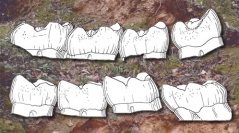

 Geodiversitas
44 (26) - Pages 753-800
Geodiversitas
44 (26) - Pages 753-800This article describes the rodents of the new fauna of Cos (Tarn-et-Garonne, Quercy) whose primates were first studied and published (Godinot et al. 2021) Among these poorly diversified rodent assemblage, the smallest species is assigned to Eogliravus wildi. All Eogliravus Hartenberger, 1971 species are redescribed here and their diagnoses are emended. Two specimens are designated as a small-sized indeterminate theridomorph. The largest and most abundant rodent represents a new species of the Theridomorph genus Masillamys namely M. cosensis n. sp. The analysis of its morphological and morphometric variability enables to highlight a high variability of the lower and upper premolars, whereas molars variability is lower. This species is compared with the late Ypresian and early Lutetian Masillamys. It represents a more derived evolutionary grade than Masillamys mattaueri Hartenberger, 1975, from Mas de Gimel (Hérault; MP10) especially by its slightly larger size, and a less derived stage than that of the Masillamys from Messel (Hesse ; MP11), especially by its still weaker hypocone relative to the protocone on the upper molars. Masillamys cosensis n. sp. also occurs in Viélase (Aveyron). These rodents pointe toward a time interval comprised between the European reference levels MP10 and MP11, near the Ypresian-Lutetian transition, and contribute to the discussion about the biochronology of this time interval.
Theridomorphs, Masillamys, Gliridae, Eogliravus, Ypresian/Lutetian transition, phosphate mines, new species